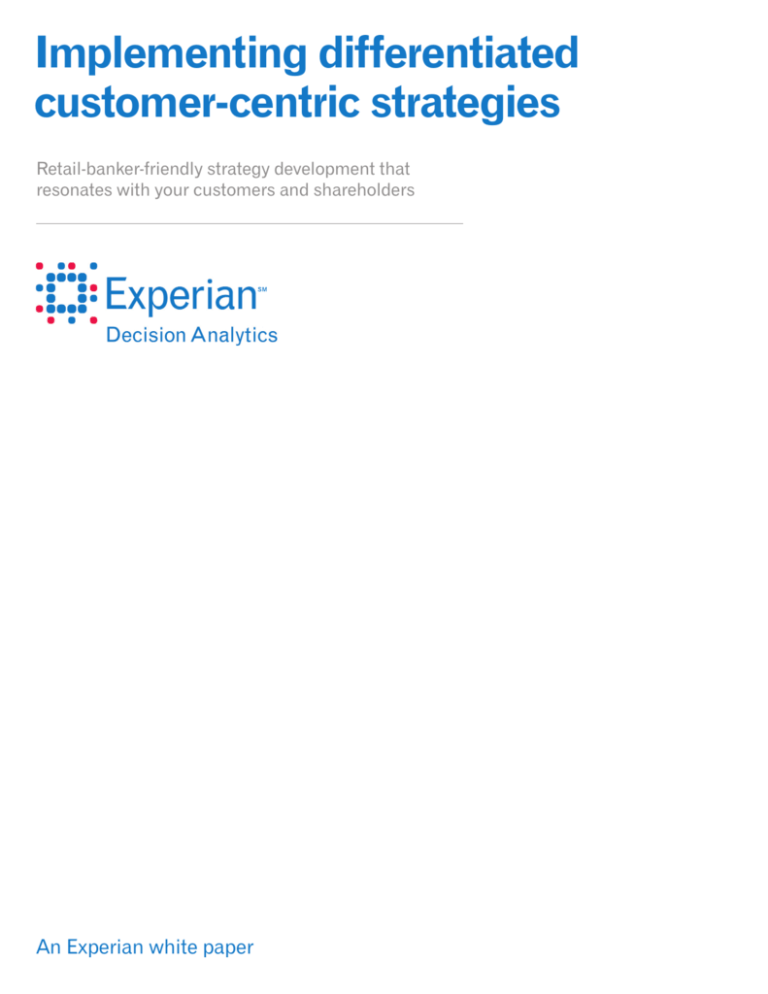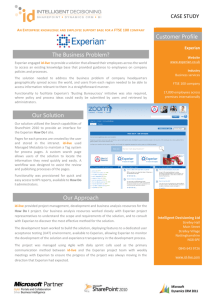
Implementing differentiated
customer-centric strategies
Retail-banker-friendly strategy development that
resonates with your customers and shareholders
An Experian white paper
Table of contents
Introduction...................................................................................................................................................2
Executive summary......................................................................................................................................3
Implementing banker-friendly customer treatment strategies............................................................4
Designing customer-centric strategies that make bankers advocates...............................................5
A pilot and strategy adoption model that works.....................................................................................7
Competitive advantage and measurable customer experience...........................................................8
Conclusion.....................................................................................................................................................9
About Experian Decision Analytics.........................................................................................................10
About the Author........................................................................................................................................10
An Experian white paper | Page 1
Introduction
Financial service organizations frequently cite superior customer management as
a key differentiator when trying to attract new clients and retain current customers.
Banking operations practices such as checking product fee assessment and waiver
policies, time deposit rate exception policies, holistic customer-level risk management
scoring and customer servicing strategies all are part of retail banks’ daily customer
management processes. Your customers know if your bank’s customer treatment
strategies are competitive and if they make it easy to do business with your bank
or not, and they likely will tell their friends and family about their experiences! A
great deal of expense for retail banking is targeted toward implementing profitable,
customer-friendly operating strategies expecting increased loyalty from existing
customers and growth in new customers. Financial institutions employ a number
of approaches, including quality programs such as Six Sigma, in efforts to institute
best practices that are most visible to their customers and use this superior customer
experience to enhance revenue. Successfully implementing customer strategies
within a retail banking or financial services environment often fails as a result
of centralized strategists missing critical information from the bank’s customerfacing employees not captured in back-end systems of record (SOR). Black-box
strategies that miss critical qualitative insights often fail to be completely adopted
across an enterprise, dying a slow and painful internal political death. This wastes
precious strategy development resource time and limited budget dollars that end up
inefficiently deployed.
This white paper proposes a framework to design and deploy holistic customercentric strategies that synthesize SOR information and qualitative banker insights
that are critical to customer experience. Customer experience resulting from new
strategies often are not considered when implementing pricing, fee management
and other customer management processes. Specifically, this paper focuses on a
best-in-class approach to designing and deploying highly profitable customer-centric
strategies fully embraced by both customers and customer-facing employees in a
retail bank setting, ultimately generating strong competitive advantages for that bank.
Page 2 | Implementing differentiated customer-centric strategies
Executive summary
This white paper is intended to be a roadmap for retail banking strategists within
centrally managed strategy teams. These strategists usually are charged with the
responsibility of developing and implementing holistic enterprise-wide customer
strategies aimed at increasing revenue, reducing customer attrition or improving the
customer’s experience.
The following topics are explored:
• Holistic customer strategies — exploiting the full value of the enterprise by
synthesizing customer knowledge from internal systems of record (SOR), external
off-your-firm financial information and critical qualitative input from customer
facing staff
• Pilot and adoption strategies — process framework for full adoption and support
from critical enterprise customer-facing staff
• Measuring customer’s voice — methods ensuring implemented strategy is fully
embraced by customers and internal support staff using survey data
• Measuring competitive advantage outcomes — measuring the long-term
financial benefits and adoption of newly implemented customer-centric strategies
Returns on investing in superior customer-centric strategies easily can exceed
20 percent in the first year of implementation, but this number is compounded
exponentially in subsequent years due to repeat business; new customer referrals;
and the customer’s general unwillingness to consider competitors, driven by
increased loyalty. Investing in customer-centric strategies guarantees your bank’s
long-term competitiveness by differentiating your organization from competitors
and by training your internal employees to proactively pay attention to what is most
important to your best customers. Banking organizations that successfully implement
holistic customer-centric strategies immediately improve operating efficiency. The
resulting customer treatment strategies are easy to understand and consistent
enterprise-wide, resulting in improved customer service scores as customers
recognize you know their relationship with your firm and such strategies increase
revenue by simplifying a customer’s ability to do business with your firm.
An Experian white paper | Page 3
Implementing banker-friendly customer treatment strategies
One of the most difficult tasks for retail banking employees is telling customers
“no” to discretionary fee refund requests or pricing exceptions for deposits or “no”
to new loans, particularly when the banker may have knowledge that policy has
missed. Best practices to building holistic customer-centric strategies and designing
complete single customer view predictive models intended to be used in retail
bank branches or call centers should synthesize complete customer information
and include quantitative (e.g., SOR data) and qualitative (e.g., banker insights)
sources. Quantitative data alone can represent only a partial picture of what may be
true reality.
As an example, occasionally fees for checking account overdrafts are charged due to
internal bank operation errors or merchant processing errors and only are recognized
when questioned by a customer. Often, the frontline bank personnel correct the
problem for the customer, but this information is never captured in back-end SOR.
There are four primary stages that should be followed when designing strategies
and scorecards intended for use within retail banking operations. These include an
initial build or design stage, the pilot or testing stage, feedback and adoption stage
and the measurement stage (Figure 1). Following this strategy rollout model ensures
your investment pays off by being embraced by the bank’s customers, employees
and shareholders.
Figure 1
Page 4 | Implementing differentiated customer-centric strategies
Designing customer-centric strategies that make bankers advocates
Designing and implementing a customer-centric strategy like bringing uniformity
to discretionary price waivers is more than saying “no” very often. Implementing
strategies that understand why the customer is asking for the exception is critical
to achieving exceptional customer service. Missing the “why” can be related to
competitor price actions and operation processing flaws when missing such
information from back-end SOR. Customer-facing employees oftentimes have
qualitative information that can augment your understanding of SOR intelligence that
is otherwise incomplete.
Effective strategy designs, even when building and deploying advanced statistical
scorecards, are best achieved with a collaborative and transparent process that
includes frontline retail banking staff perspectives. Designing treatment strategies
and servicing strategies that include qualitative insights is prudent and results in
better customer management. Rigid strategies that do not allow for qualitative
insights result in resistance and low adoption by customer-facing employees.
This can drive off your best customers and cost banks millions of dollars in failed
implementations.
Retail banks with excellent customer service often achieve success by empowering
customer-facing employees to fix inadequacies of black-box treatment strategies
and predictive models that miss qualitative insights only discovered through face-toface customer interactions. Some critical steps to take into account when building
customer treatment strategies and models for use in retail banking centers and call
centers include:
1. Aggregate the complete set of client information from all internal SOR, thirdparty data and qualitative information, ensuring a complete relationship view
2. Build flexibility into designs, allowing practical rule-based overlays
3. Use banker experiences to interpret and explain back-end data in SOR by
leveraging qualitative surveys, branch observation studies and team huddles
4. Design success metrics to include profit targets (return on investment, or
ROI) and customer satisfaction improvement, satisfying both shareholders
and customers
An Experian white paper | Page 5
Figure 2
Methodologically accepted sound statistical testing, repeatable results and rigorous
approaches to model building are important to use when designing treatment
strategies and building models, but may not be enough to yield common-sense
experiences for customers and bankers. Building treatment strategies and predictive
models with the realization and expectation you will need to modify as you learn will
ensure full adoption and sound customer management approaches that win new
client business and retain existing clients.
Page 6 | Implementing differentiated customer-centric strategies
A pilot and strategy adoption model that works
Often Challenger strategy metrics focus exclusively on statistical analyses as
the single criteria of success and ignore qualitative measures of success. Sound
approaches to Challenger strategies should include metrics that are statistically
valid and repeatable, but failure based on this alone doesn’t always indicate the
Challenger approach is inferior to existing strategies. There are several reasons
why success metrics can fail unrelated to the actual strategy itself. These include
faulty test designs, poorly implemented pilot approaches, and tests that ignore
and don’t incorporate qualitative insights from customer-facing employees. This
usually guarantees low employee support for the initiative, ensuring the pilot is
unsuccessful. Do not discount the ability of employees to derail unpopular customer
treatment initiatives in large and small banks alike. Adopting testing approaches that
incorporate iterative learning through collaboration with customer-facing employees
in branches and call centers will guarantee successful holistic customer treatment
strategies and wide adoption by customer-facing employees. The piloting phase is a
critical time for successful strategy implementation that demands several steps be
initiated to prevent derailing successful results:
1. Pilot branch bank and call centers separately — Delineate test and control
branches and call center employee groups and enable clear lift measurement
2. Start and end Challenger pilots with employee engagement sessions,
fostering transparency and honest feedback — Use surveys and team huddles
3. Actively engage key influencers — Enable buy-in and employee adoption
4. Establish adoption metrics to track and coach daily — Allow rapid continuous
improvement, and measure overrides in total units and dollars
5. Analyze results and make strategy changes objectively — Coach resistant
employees by actively confronting conventional wisdom and discussing facts
6. Be on-site during the pilot — Conduct call listening and observe face-to-face
customer interactions
Actively engaging customer-facing staff to learn and modify and align strategy
designs and predictive models to the real world will improve adoption and satisfy
customers, bankers and shareholders. This engagement process also guarantees
that quantitatively designed strategies and models incorporate critical qualitative
insights. The engagement process also allows the strategy implementation team
an opportunity to confront low adoption issues with facts that result in employee
goodwill, as the original design is adapted during the pilot. A collaborative approach,
blending art and science, ensures complete adoption from customer-facing bankers
and measurable customer experience improvements that are monetized for
shareholders through improved customer retention and new customer acquisitions.
An Experian white paper | Page 7
Competitive advantage and measurable customer experience
Establishing objective measures of success is critical to making sure the piloted
strategy meets financial hurdles without creating mass attrition with existing
customers. Regardless of what is being implemented — such as deposit products
fee management policies, time deposit rate exceptions policies, customer servicing
strategies, or risk assessment models and treatment strategies — it’s critical that
shareholders and customers are served by these strategies. Establishing clear metrics
for success and accurately monitoring these metrics ensures consistent outcomes.
There are several key performance indicators (KPIs) that should be used during the
pilot that can assess if Challenger approaches warrant full-scale adoption. These KPI
metrics include the following:
1. Manage manual overrides — measurement should include number of override
incidences and dollar cost associated with each instance and provided to
management as coaching with regular reporting
2. Incremental financial lift for Challenger versus Champion — Annualized ROI
should include incremental costs associated with full implementation in addition
to realistic revenue estimates
3. Customer satisfaction lift for Challenger versus Champion — Ensure minimal
customer attrition impacts and verify retention assumptions
4. Consider integrating new metrics in incentive programs — Customer-facing
management can use these metrics to institutionalize new strategies
5. Implement continuous improvement metrics — Monitor and periodically modify
your strategy, ensuring alignment to the current operating environment
Following this implementation approach ensures the design is truly a holistic
customer-centric treatment that has fully accounted for all information the enterprise
contains by synthesizing quantitative and qualitative insights. Because the strategy
has been objectively vetted from a financial Champion/Challenger approach using
ROI and results in improved customer satisfaction, strict adherence to policy now can
be enforced. Frontline banking employees, having been included in the development,
now own results and can be accountable for fully implementing and adopting the
changes. Fully institutionalizing the new processes with alignment to incentives
is recommended, although not all organizations go to this extent. Continuous
monitoring of results and continually adapting the strategy as changes necessitate is
best practice.
Page 8 | Implementing differentiated customer-centric strategies
Conclusion
This paper has put forth a framework for designing, testing and implementing
retail banking customer treatment strategies and models in a way that synthesizes
quantitative and qualitative enterprise customer information. In addition, the
framework implementation results in franchise-wide participation in the process,
minimizing tensions that arise from deployment of black-box strategies and models
between central strategy teams and frontline customer-facing employees. In
reality, the holistic customer management solution results from a truly enterprise
view whereby your customer benefits the most. This approach will guarantee the
financial institution is seen as providing intuitive, best-in-class service to customers
and providing shareholders with optimal returns on investments. Adopting
holistic approaches to developing and deploying customer-centric strategies by
institutionalizing collaborative working arrangements cross-functionally is the key
to providing best-in-class customer service and breakthrough revenue growth for
financial institutions embracing such approaches.
Figure 3
The above illustrates typical customer-centric treatment processes where the
framework can be used to ensure successful strategy implementations.
An Experian white paper | Page 9
About Experian Decision Analytics
Experian Decision Analytics enables our clients to make analytics-based customer
decisions that support their strategic goals, so they can achieve and sustain
significant growth and profitability. Through our unique combination of consumer and
business information, analytics, decisions, and execution, we help clients to maximise
and actively manage customer value.
Meaningful information is key to effective decision-making, and Experian is expert in
connecting, managing, interpreting and applying data, transforming it into information
and analytics to address real-world challenges. We collaborate closely with clients
to identify what matters most about their business and customers, then create and
implement analytics-based decisions to manage their strategies over time.
In today’s fast-paced environment where developing, implementing, and sustaining
an effective strategy is imperative, Experian Decision Analytics helps organisations
unlock a wealth of benefits immediately — and set the stage for long-term success.
Increased revenue: Our products and services enable clients to increase revenue
by providing the insight and agility they need to find and engage the right customers,
target products more effectively, and grow market share.
Controlled risk: A broad range of risk-management products and services help
our clients to verify identity and manage and detect fraud, optimise collection and
recovery, and balance risk and reward.
Operational efficiency: Experian Decision Analytics helps our clients to quickly
integrate various information and processes to enhance operational efficiency
and boost agility. Our flexible, collaborative approach helps organisations
increase speed to market, enhance business agility and improve the quality of
customers’ experiences.
Compliance as differentiation: Proven expertise lets clients use compliance
as source of competitive advantage. Experian Decision Analytics helps ensure
compliance with essential regulations, while helping organisations better
understand customers.
About the Author
John Taylor is a senior business consultant with Experian’s Global Consulting
Practice, who provides financial services organizations with effective strategies to
attract, retain and manage profitable deposit customers. Having spent more than
17 years in the financial services industry, Taylor understands the factors that increase
competition among organizations to win deposit accounts and comply with new
government regulations. He provides strategies and advice that focus clients on
building deposits profitably and grow customer relationships.
Prior to joining Experian, he held senior leadership positions at Bank of America,
Wachovia, Wells Fargo and TIAA-CREF. Taylor is an alumnus of Northeastern Illinois
University and the University of North Carolina.
Page 10 | Implementing differentiated customer-centric strategies
Experian
475 Anton Blvd.
Costa Mesa, CA 92626
1 888 808 8242
www.experian.com
© 2012 Experian Information Solutions, Inc. • All rights reserved
Experian and the Experian marks used herein are service marks or
registered trademarks of Experian Information Solutions, Inc.
Other product and company names mentioned herein are the
property of their respective owners.







